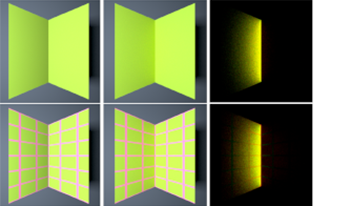
Fluorescence is an optical phenomenon, specific to certain materials that absorb light with higher energy and re-emit it at lower energy, with unnoticeable time latency. Due to this so-called Stokes shift, fluorescent materials pose several challenges in image capture, where usually a filtering setup is required at the illumination and/or sensing ends. Nevertheless, fluorescence emission is diffuse, which was previously used in shape from photometry models. In this work, we target the shape from fluorescence method for a specific category of materials: those with overlapping reflectance and fluorescence signals. In particular, we investigate how the self-interreflections (light bounces off a surface that get re-reflected by the surface itself) change the appearance of scenes with such fluorescent materials and how this affects the shape estimation with a photometric stereo model. To avoid instrumental artifacts inherent in real image capture setups, we perform our analysis on a synthetic dataset of multi-light images, generated with a physically-based spectral renderer that supports fluorescence.

Industrial machine vision applications frequently employ Photometric Stereo (PS) methods to detect fine surface defects on objects with challenging surface properties. To achieve highly precise results, acquisition setups with a vast amount of strobed illumination angles are required. The time-consuming nature of such an undertaking renders it inapt for most industrial applications. We overcome these limitations by carefully tailoring the required light setup to specific applications. Our novel approach facilitates the design of optimized acquisition setups for inline PS inspection systems. The optimal positions of light sources are derived from only a few representative material samples without the need for extensive amounts of training data. We formulate an energy function that constructs the illumination setup which generates the highest PS accuracy. The setup can be tailored for fast acquisition speed or cost efficiency. A thorough evaluation of the performance of our approach will be given on a public data set, evaluated by the mean angular error (MAE) for surface normals and root mean square (RMS) error for albedos. Our results show, that the obtained optimized PS setups can deliver a reconstruction performance close to the ground truth, while requiring only a few acquisitions.